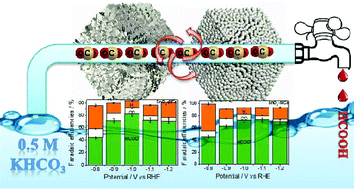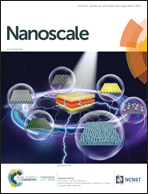Intentional construction of high-performance SnO2 catalysts with a 3D porous structure for electrochemical reduction of CO2†
Abstract
Herein, SnO2-NC (SnO2-nanocube) and SnO2-NF (SnO2-nanoflake) electro-catalysts featuring a large specific surface area and 3D porous structure were successfully constructed via acid etching and sulfurization–desulphurization methods, respectively. As catalysts for the electrochemical reduction of CO2, the faradaic efficiency (FHCOO−+CO = 82.4%, 91.5%, respectively) and partial current density (jHCOO−+CO = 10.7 and 11.5 mA cm−2, respectively) of SnO2-NCs and SnO2-NFs were enhanced in comparison with SnO2-NPs (SnO2-nanoparticles, FHCOO−+CO = 63.4%, jHCOO−+CO = 5.7 mA cm−2) at −1.0 V vs. RHE. The enhanced catalytic activity is attributed to their uniform 3D porous structure, high specific surface area and excellent wettability. Additionally, the morphology of SnO2-NCs and SnO2-NFs was largely preserved after electrolyzing for 12 h (after 12 h of electrolysis), indicating the effective buffering effect of the 3D structure in electrolysis. Naturally, the current density and faradaic efficiency of the SnO2-NC and SnO2-NF catalysts remained nearly unchanged after long-term stability measurements, revealing great stability.



 Please wait while we load your content...
Please wait while we load your content...